Essenes Meaning in the Bible: Asceticism and Purity
The Essenes were a Jewish sect from the Second Temple period, notable for their ascetic lifestyle and communal living. Though not explicitly named in the Bible, their practices align closely with descriptions of purity, asceticism, and communal ethics.
The Dead Sea Scrolls, often attributed to the Essenes, illuminate their theological beliefs, emphasizing ritual purity, eschatological expectations, and distinctive scriptural interpretations. Their unique lifestyle and beliefs provide critical insights into Second Temple Judaism and early Christian thought, particularly through archaeological finds at Qumran.
For a deeper understanding of their influence and practices, one must examine further evidence and scholarly interpretations.

Essenes Meaning in the Bible: Origins, Beliefs, and Biblical Relevance
| Aspect | Biblical Insight |
|---|---|
| Who Were They | A strict Jewish sect known for piety, communal living, and ascetic practices |
| Time Period | Active from 2nd century BCE to 1st century CE |
| Biblical Mention | Not directly named in the Bible but inferred through historical context |
| Key Beliefs | Purity, separation from society, messianic expectations |
| Spiritual Significance | Linked to the Dead Sea Scrolls and possible influence on early Christianity |
| Location | Mainly in Qumran near the Dead Sea |
Historical Context of the Essenes

The Essenes were a Jewish sect that emerged during the Second Temple period, roughly between the 2nd century BCE and the 1st century CE, distinguished by their communal lifestyle and strict adherence to religious purity.
This period was marked by significant social, political, and religious upheaval within Judea, influenced by Hellenistic culture and Roman occupation. The fragmentation of Jewish society led to the formation of various sects, including the Essenes, Pharisees, and Sadducees.
The Essenes are often associated with the Dead Sea Scrolls, a collection of texts that provide insight into their beliefs and practices. Their existence and activities were documented by contemporary historians like Josephus, Philo, and Pliny the Elder, offering a valuable perspective on their role within the broader Jewish context.
Characteristics of the Essenes

Known for their ascetic lifestyle, the Essenes exhibited characteristics such as communal living, rigorous observance of purity laws, and a strong emphasis on piety and ritual purity.
Their communities were often secluded to maintain spiritual and physical cleanliness, distancing themselves from what they perceived as a corrupt society.
Members shared possessions, reflecting their commitment to communal support and equality. The Essenes practiced daily purification rituals and adhered strictly to Sabbath observance and dietary laws.
Additionally, they engaged in frequent prayer and scriptural study, underscoring their devout nature.
This disciplined way of life was believed to prepare them for divine favor and spiritual enlightenment, distinguishing them from other contemporary Jewish groups.
Beliefs and Practices

The Essenes adhered to a distinctive set of beliefs and practices that emphasized communal living principles and ritual purity.
Their commitment to sharing possessions and resources distinguished them from other Jewish sects, while their rigorous purification rituals underscored a profound dedication to spiritual cleanliness.
These practices were not merely symbolic but integral to their theological framework and daily life, reflecting a holistic approach to religious observance.
Communal Living Principles
Essenes’ communal living principles were deeply rooted in their commitment to asceticism, ritual purity, and a collective lifestyle that emphasized shared resources and mutual support.
Their communities were characterized by a strict adherence to communal ownership, where personal possessions were relinquished for the greater good. This radical form of economic collectivism was underpinned by a strong ethical framework, fostering an environment of mutual aid and social equality.
Daily life was highly regulated, with members adhering to rigorous schedules of work, study, and worship. Decision-making processes were democratic, involving the collective input of members, thereby reinforcing the sense of unity and shared purpose.
Through these principles, the Essenes sought to create a harmonious and spiritually focused community.
Ritual Purity Practices
Rooted in their stringent interpretations of Jewish law, the Essenes’ ritual purity practices were integral to their spiritual life and communal identity.
These practices included regular immersion in water, akin to the Jewish mikvah, which they believed was essential for maintaining spiritual and physical cleanliness.
The Essenes adhered to strict dietary laws and avoided contact with non-members to prevent ritual contamination.
They often wore white garments symbolizing purity and conducted their meals and daily activities in a meticulously clean environment.
Such practices underscored their commitment to holiness and separation from perceived impurities, reflecting a broader theological emphasis on purity as a prerequisite for divine communion.
These rigorous observances distinguished them from other Jewish sects of the time.
The Dead Sea Scrolls

The Dead Sea Scrolls, discovered in the mid-20th century near Qumran, have provided unparalleled insights into the beliefs, practices, and daily life of the Essenes.
These ancient manuscripts encompass a wide array of texts, including biblical manuscripts, sectarian writings, and apocalyptic literature, which together illuminate the theological and communal aspects of this enigmatic group.
The preservation and subsequent analysis of these scrolls have profoundly impacted our understanding of Second Temple Judaism and early Christian thought.
Discovery and Significance
Uncovered in a series of caves near Qumran between 1947 and 1956, the Dead Sea Scrolls have provided critical insights into the religious practices and beliefs of the Essenes. These ancient manuscripts are invaluable for understanding the socio-religious landscape of Second Temple Judaism. The location and contents of the scrolls suggest a sect dedicated to rigorous piety and communal living.
| Aspect | Details |
|---|---|
| Location | Qumran, near the Dead Sea |
| Discovery Period | 1947-1956 |
| Manuscript Types | Biblical texts, sectarian writings, hymns |
| Language | Primarily Hebrew and Aramaic |
| Significance | Insight into 2nd Temple Jewish practices |
The scrolls offer a rare glimpse into the theological and liturgical frameworks of the Essenes, contributing substantially to biblical scholarship and historical understanding.
Content and Insights
Building upon the discovery and significance of the Dead Sea Scrolls, the content found within these manuscripts provides profound insights into the theological doctrines, ritual practices, and communal regulations of the Essenes.
These texts, including the Community Rule and the War Scroll, delineate a strict code of conduct and communal living, emphasizing purity, asceticism, and eschatological expectations.
The Scrolls reveal a dualistic worldview, with an emphasis on the cosmic struggle between light and darkness.
Additionally, they shed light on the Messianic expectations prevalent among the Essenes, highlighting their anticipations of an imminent divine intervention.
These documents are invaluable for understanding the religious landscape of Second Temple Judaism, illustrating the distinct beliefs and practices that characterized the Essene community.
Preservation and Impact
Amidst challenging environmental conditions, the remarkable preservation of the Dead Sea Scrolls has enabled scholars to gain unprecedented insights into the religious and cultural milieu of the Essenes.
These ancient manuscripts, discovered in the mid-20th century near the Qumran Caves, offer a window into the theological doctrines, communal practices, and daily lives of this enigmatic Jewish sect.
The scrolls include biblical texts, apocryphal writings, and sectarian documents that highlight the Essenes’ emphasis on ritual purity and eschatological expectations.
The preservation of these texts, due to the arid climate and protective cave environments, has greatly impacted our understanding of Second Temple Judaism and the early roots of Christianity, reshaping historical and theological scholarship.
Community Structure

The community structure of the Essenes, as described in historical and biblical texts, was characterized by a strict hierarchy and communal living arrangements that emphasized asceticism and shared resources.
Leadership within the Essene community was typically vested in a council of elders who oversaw both spiritual and practical matters. Members were required to undergo rigorous initiation processes, including a probationary period, before full integration.
Resources, including food and property, were collectively owned, reflecting their commitment to communal living and equality. The hierarchical order extended to daily duties and religious observances, ensuring that each member contributed to the community’s upkeep and spiritual well-being.
This structured lifestyle underscored their devotion to purity, discipline, and separation from wider society.
Daily Life and Routines
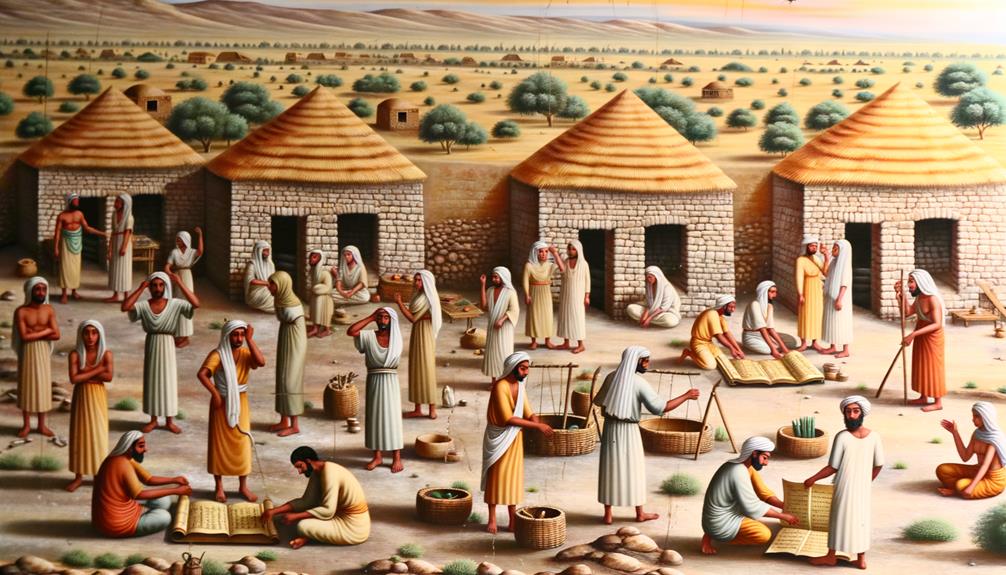
Frequently adhering to a regimented schedule, daily life for the Essenes was meticulously organized to reinforce their spiritual and communal values. Their days began before sunrise with morning prayers, followed by communal meals characterized by ritual purity.
Labor was divided among community members, with tasks ranging from agricultural work to scriptural study. The Essenes emphasized manual labor not merely for sustenance but as an act of devotion.
Afternoons were often dedicated to further religious study and communal activities, fostering a strong sense of unity. Evening meals were also communal and preceded by ritual purification.
The day concluded with prayers and contemplation, underscoring the continuous integration of spiritual practice into daily routines. This structured lifestyle was pivotal in maintaining their religious commitments.
The Essenes and Judaism
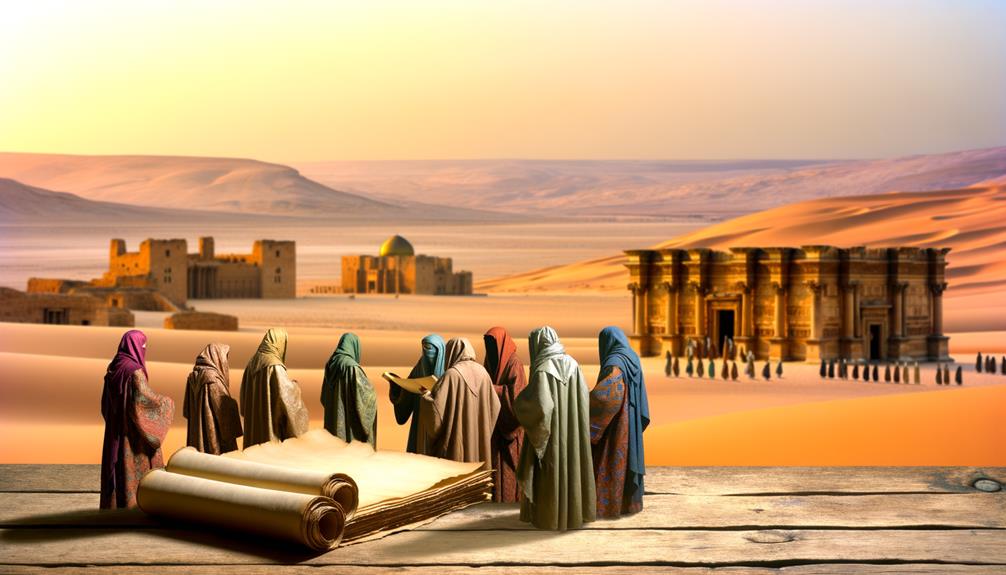
Exploring the relationship between the Essenes and broader Jewish traditions reveals a distinct yet interconnected strand within the tapestry of Second Temple Judaism.
The Essenes, known for their ascetic lifestyle and communal living, adhered strictly to the Torah, yet diverged from mainstream Jewish practices in significant ways.
They emphasized ritual purity, communal ownership, and eschatological beliefs that set them apart from the Pharisees and Sadducees. Their meticulous observance of the Sabbath and distinctive calendar system further illustrate their unique interpretations of Jewish law.
Despite these differences, the Essenes shared core Judaic tenets, such as monotheism and covenantal theology, reflecting a complex interplay of conformity and differentiation within the broader Jewish religious landscape of the period.
The Essenes and Early Christianity
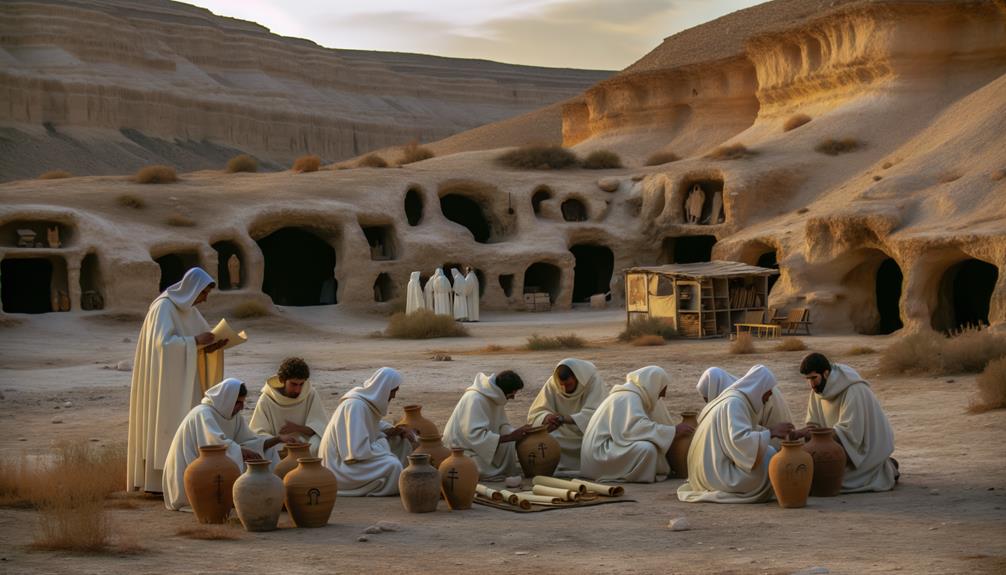
Intersecting trajectories between the Essenes and early Christianity reveal a fascinating dialogue of religious thought and practice. Scholarly analyses suggest several points of convergence that may have influenced early Christian doctrines and community structures.
These intersections include:
- Ascetic Practices: Both groups emphasized ascetic lifestyles, advocating for celibacy, communal living, and dietary restrictions.
- Apocalyptic Beliefs: The Essenes and early Christians shared apocalyptic expectations, anticipating an imminent divine intervention and the establishment of God’s kingdom.
- Scriptural Interpretations: Both communities engaged in distinctive interpretations of Hebrew Scriptures, often emphasizing prophecies and messianic expectations.
- Baptismal Rites: Ritual purification, a hallmark of Essene practice, finds echoes in early Christian baptismal rites, symbolizing spiritual rebirth and cleansing.
These elements underscore a complex and multilayered interaction that warrants further scholarly exploration.
Biblical References and Allusions
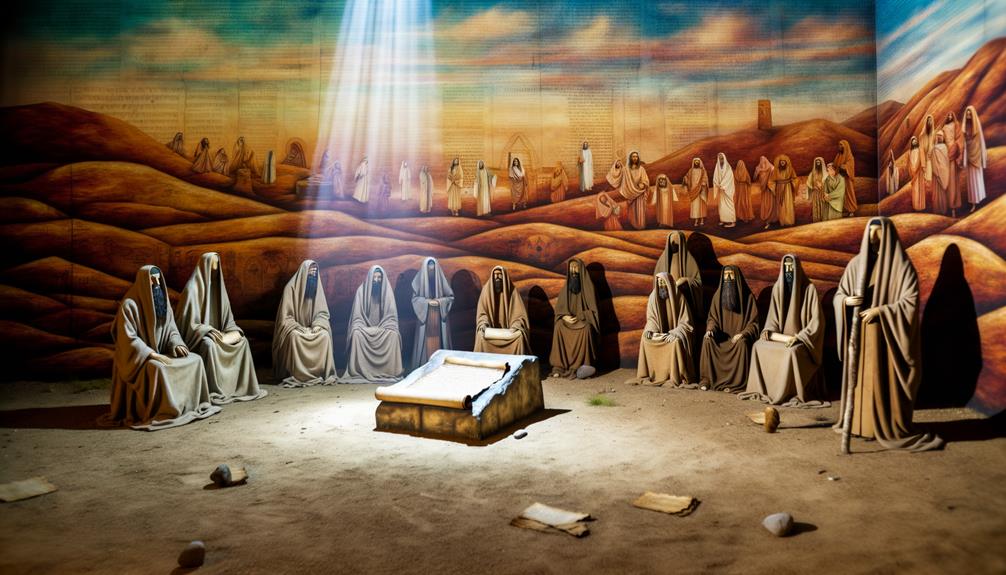
How are the Essenes represented or alluded to within the biblical texts, and what can these references reveal about their influence on the broader religious landscape of the period?
Biblical texts do not explicitly mention the Essenes by name. However, indirect allusions may be discerned in passages describing communities devoted to rigorous purity, asceticism, and communal living, such as in the practices of John the Baptist.
The Dead Sea Scrolls, while not part of the canonical Bible, offer a closer understanding of such sects. These allusions, coupled with extra-biblical writings by historians like Josephus and Philo, suggest the Essenes’ significant role in shaping early Jewish religious thought and practices, particularly regarding apocalyptic expectations, communal ethics, and ritual purity.
Archaeological Discoveries
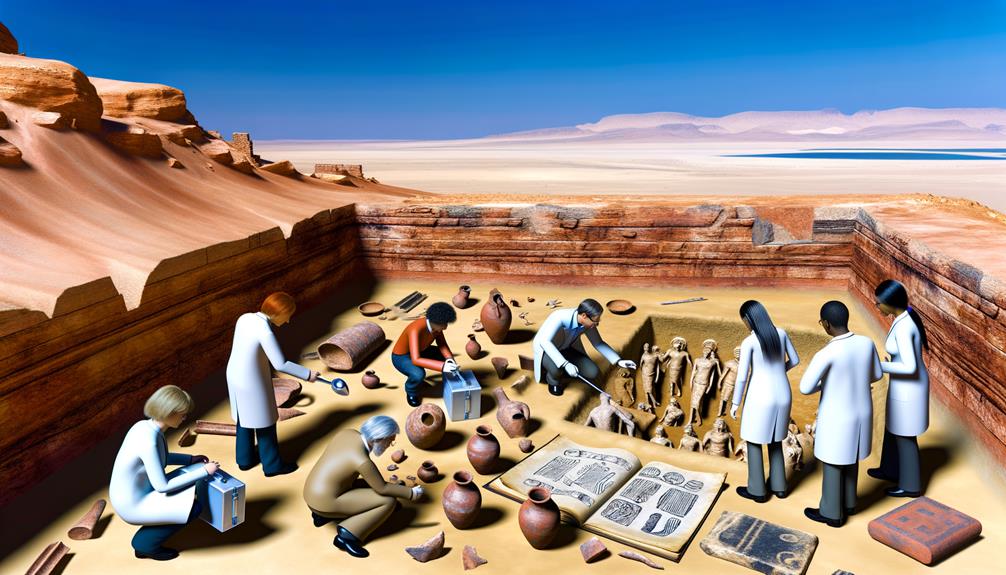
Archaeological discoveries, particularly the Dead Sea Scrolls, have provided substantial information regarding the Essenes and their practices.
These ancient manuscripts, found near the Qumran settlement, offer valuable insights into the community’s religious beliefs and daily life.
Through these findings, scholars can better understand the historical and cultural context of the Essenes’ influence on biblical texts.
Dead Sea Scrolls
The discovery of the Dead Sea Scrolls has provided invaluable insights into the beliefs, practices, and daily life of the Essenes. These ancient manuscripts, unearthed in the mid-20th century, have greatly enhanced our understanding of this Jewish sect.
The scrolls, which date from the third century BCE to the first century CE, include a variety of texts that illuminate the Essenes’ religious framework and community rules.
Key findings from the Dead Sea Scrolls include:
- Biblical Manuscripts: Fragments of nearly every book in the Hebrew Bible.
- Sectarian Texts: Documents specific to the Essenes, such as the Community Rule.
- Hymns and Prayers: Liturgical compositions that reflect their worship practices.
- Commentaries: Interpretative writings on biblical texts, revealing their theological perspectives.
Qumran Community Insights
Building on the valuable information gleaned from the Dead Sea Scrolls, excavations at Qumran have further enriched our understanding of the Essenes’ communal and daily life.
Archaeological findings, including communal dining halls, ritual baths, and writing rooms, offer tangible evidence of their structured, ascetic lifestyle.
The artifacts discovered, such as pottery, tools, and manuscripts, provide significant insights into their religious practices and social organization.
| Artifact Type | Description | Significance |
|---|---|---|
| Pottery | Various household items | Indicates daily activities and trade |
| Ritual Baths | Purification structures | Highlights religious and purity practices |
| Manuscripts | Written texts and scrolls | Offers insights into beliefs and doctrines |
These discoveries collectively illustrate the Essenes’ commitment to a disciplined, communal existence, reflecting their spiritual dedication and societal norms.
Modern Interpretations and Debates

Examining modern interpretations and debates surrounding the Essenes reveals diverse scholarly perspectives that challenge traditional biblical narratives.
Researchers question the once widely accepted identification of the Essenes with the Qumran community, proposing various alternative viewpoints.
Key areas of debate include:
- Historical Accuracy: Evaluating ancient texts and archaeological evidence to verify the existence and practices of the Essenes.
- Sectarian Identity: Differentiating the Essenes from other contemporary Jewish groups like the Pharisees and Sadducees.
- Theological Influence: Investigating the potential impact of Essene beliefs on early Christian thought.
- Textual Variance: Analyzing discrepancies between the Dead Sea Scrolls and other historical documents to understand Essene doctrine.
These ongoing discussions aim to refine our comprehension of the Essenes’ role in biblical history.
Conclusion
The Essenes, a sect shrouded in unparalleled historical significance, epitomize the quintessence of asceticism and religious fervor.
Their profound influence permeates through their rigorous beliefs, communal practices, and the monumental discovery of the Dead Sea Scrolls.
The intricate relationship between the Essenes and early Christianity further amplifies their critical role in religious history.
Modern interpretations and archaeological revelations continue to ignite fervent academic debates, underscoring the Essenes’ indelible impact on biblical scholarship and historical discourse.






